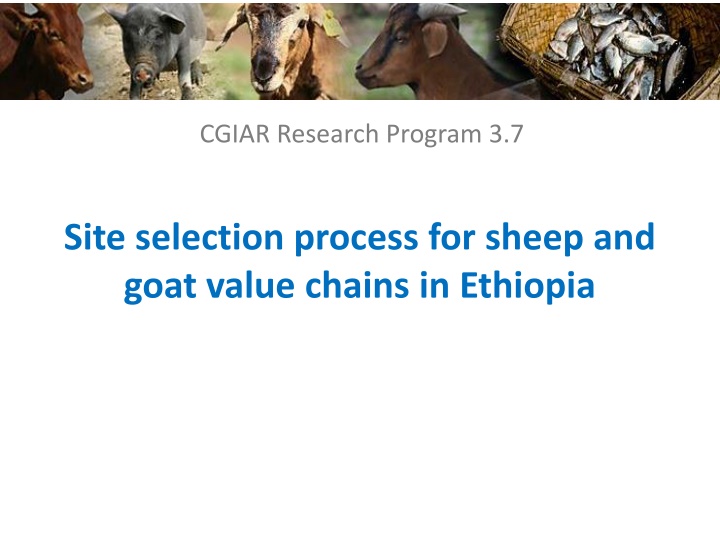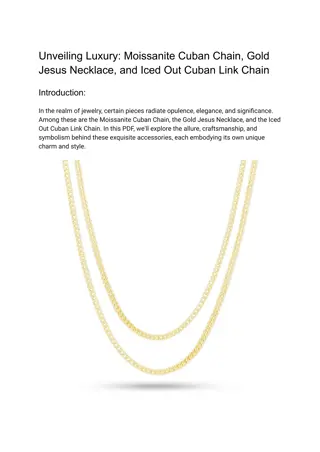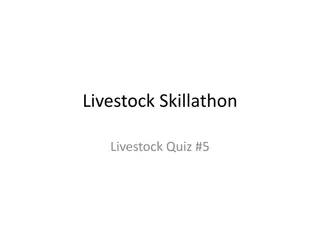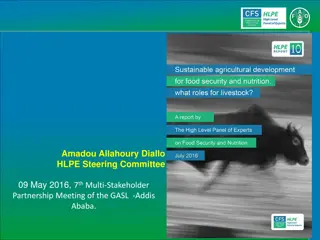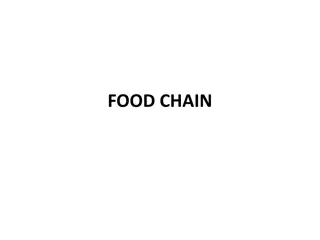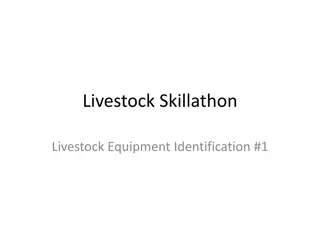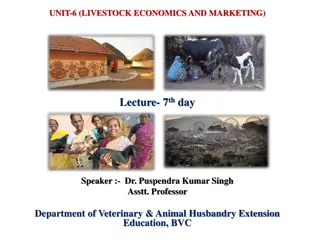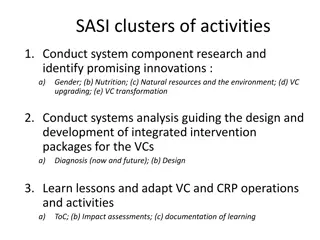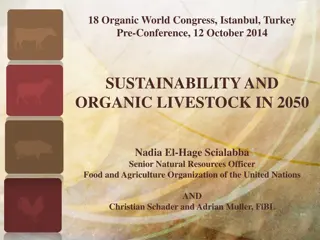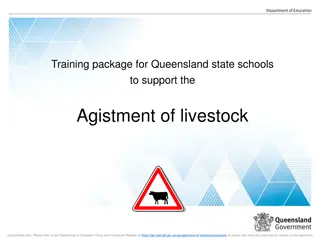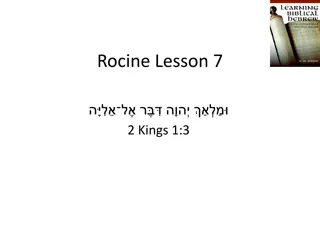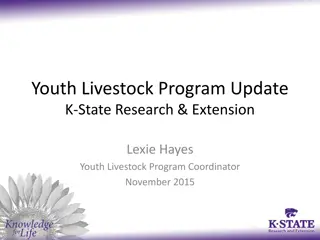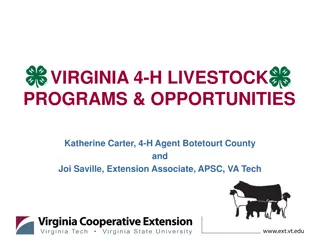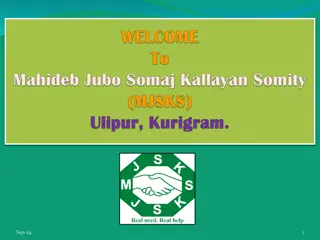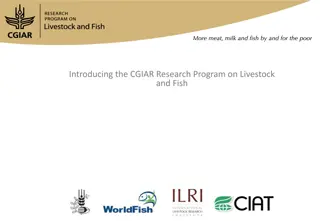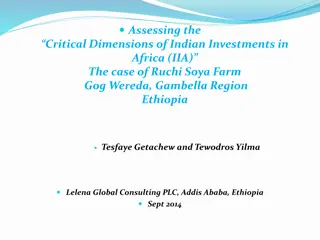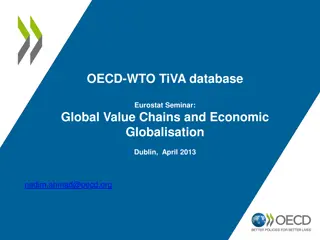Site Selection Process for Livestock Value Chains in Ethiopia
This document outlines the site selection process for sheep and goat value chains in Ethiopia, focusing on geographical targeting, stakeholder consultations, site visits, and analysis for final site selection. It also discusses the rationale for selecting potential livestock value chains based on growth opportunities, pro-poor potential, outscaling interventions, and researchable supply constraints.
Download Presentation

Please find below an Image/Link to download the presentation.
The content on the website is provided AS IS for your information and personal use only. It may not be sold, licensed, or shared on other websites without obtaining consent from the author.If you encounter any issues during the download, it is possible that the publisher has removed the file from their server.
You are allowed to download the files provided on this website for personal or commercial use, subject to the condition that they are used lawfully. All files are the property of their respective owners.
The content on the website is provided AS IS for your information and personal use only. It may not be sold, licensed, or shared on other websites without obtaining consent from the author.
E N D
Presentation Transcript
CGIAR Research Program 3.7 Site selection process for sheep and goat value chains in Ethiopia
Site selection process proposed for the Livestock and Fish CRP Step 1: Geographical targeting - identification of potential regions/districts for selection using GIS Stakeholder consultations (ground-truthing of Step 1 and defining soft selection criteria) Minimum checklist to gather data for more specific site selection Analysis of Step 1 3 and final site selection Mobilization and start of activities in selected sites Step 2: Step 3: Step 4: Step 5:
Site selection process in Ethiopia Step 1: Geographical targeting - identification of eligible regions/districts using GIS Stakeholder consultation at national level (ground-truthing of Step 1, defining soft selection criteria and identifying sites) Regional stakeholder consultation to refine site selection and prepare site visits Site visits applying agreed minimum checklist to validate selected sites Analysis of Step 1-4 and final site selection Mobilization and start of activities in selected sites Step 2: Step 3: Step 4: Step 5: Step 6:
Rationale for selecting potential livestock value chains 1. Growth and market opportunity: Is there evidence of increasing demand for the commodity, locally or regionally? What is the importance of the commodity for people s livelihoods? 2. Pro-poor potential: How will the poor be involved? Is there evidence they can play a significant role in increased production, or being employed in value chain activities, or will benefit from increased consumption?
Rationale for selecting potential livestock value chains 3. Potential for outscaling interventions/solutions: Agroeciological conditions of the site representative for large areas within the same country? 4. Researchable supply constraints: Are there supply constraints, such as large productivity gaps or transactions costs for which research may be able to provide solutions, and would create production and welfare gains?
Step 1: Geographical targeting using GIS - identification of potential regions/districts for selection
Translating rationale into spatial criteria for small ruminant value chains in Ethiopia Representativeness: agroecological potential (number of growing days, prod systems) Growth and market opportunity: sheep and goat density, market linkage (distance/time to next market), supply deficit Pro-poor potential: number or proportion of poor people; number of poor sheep and goat keepers Supply constraints (scope for improvement): low productivity or surplus-deficit in meat production
Geographical targeting with GIS Representative agro-ecological conditions High to medium poverty High sheep and goat densities Contrasting market access/domains
Example: Agro-ecological conditions Rangeland based Mixed rainfed Mixed irrigated Figure 1: Distribution of livestock production systems in Ethiopia (derived from Robinson et al., 2011)
Agro-ecological conditions Table 1: Surface area of production systems in Ethiopia (derived from Robinson et al., 2011) Production system Area Percentage (%) 45.4 1.4 1.4 18.3 4.8 25.2 0.5 3.0 Rangeland based, (Hyper-) Arid/Semi-arid (LGA) 498,100 Rangeland based, Humid/Sub-humid (LGH) 15,100 Rangeland based, Temperate/Tropical highlands (LGT) 15,100 Mixed, (Hyper-) Arid/Semi-arid (MRA) 200,100 Mixed, Humid/Sub-humid (MRH) 52,600 Mixed, Temperate/Tropical highlands (MRT) 276,700 Urban 5,100 Other 33,300 Focus on: Rangeland based, Arid/Semi-arid (LGA) Mixed, Arid/Semi-arid (MRA) Mixed, Temperate/Tropical highlands (MRT)
Agro-ecological conditions Figure 2: Areas with representative farming systems (LGA, MRA and MRT) for Ethiopia (in green, all other areas in grey)
Step 2: Stakeholder consultation at national level 6 July 2012 in Addis - Discuss outcome of step 1 (geographical targeting) - Define and apply soft criteria - Propose list of eligible sites for sheep and goat VCs matchingwith agreed criteria
Feedback on geographical targeting Poverty level should be defined with more country- specific criteria; some data were doubtful Applying high sheep and goat density excludes lowland systems, where the flock size is highest and the people depend fully on livestock Predefined market domains (rural to rural and rural to urban) do not match with Ethiopian marketing reality could try domestic versus expert or even better 'ease of market access'. further cross-checking needed
Fuzzy soft selection criteria for sheep and goat value chains Synergy with on-going research Government priorities Potential for success implementation and impact Existing links with research and extension system Regional representation Availability of secondary data
Killer selection criteria for sheep and goat value chains Likelihood of success Market potential Well known supply areas for sheep or goat meat Proximity to Addis Number of sheep and goats per household Importance of sheep and goats to household livelihoods
List of proposed sites for sheep and goat value chains (6 July 2012) Selected sites Region District/ Woreda Market link Research Center Goat value chains Tanka Abergelle Konso Dillo Asaita Negelle Borena Shinelle Sheep Value chains Menz Yabello Horro Werer East Tigray Gurage/Silte Arsi Gamo Goffa Tigray SNNP Oromia Afar Oromia Somali Tanka Karat Dillo Asaita Liben Shinelle rural rural rural rural urban urban Abergelle Arba Minch Yabello Afar Bore Haromaya Amhara Oromia Oromia Afar Tigray SNNP Oromia SNNP Menz Gera Yabello Horro Gudru Amibara Atsbi Wonberta Alicho Wuriro Sagure Ditta urban urban rural urban urban urban rural rural Debre Berhan Yabello Bako Werer Mekelle Worabe Kulumsa Arba Minch
Targets and criteria applied for reducing the list of sheep and goat value chains Target value chains: 2 goat and 4 sheep value chains Target production systems: 2 lowland and 4 highland sites Partner research and development projects to ensure initial funding of activities Priorities of the government to ensure interest and investment of research and extension system Cover well known sheep and goat breeds with high market potential Ease of implementation and probability of quick success Balanced regional representation
Reduced list of proposed sites for sheep and goat value chains (23 July 2012) Selected sites Region District/ Woreda Partner project Research Center Goat Value Chains Abergelle Amhara BecaHub Goat Project Negelle Borena Goat and Sheep Value Chain Shinelle Oromia Liben Bore Somali Shinelle PCDP Haromaya University Sheep Value Chains Menz Horro East Tigray Adillo/Wolaita Amhara Oromia Tigray SNNP Menz Gera Horro Gudru Atsbi Wonberta GIZ LIVES LIVES Debre Berhan Bako Mekelle Worabe Other Priority Learning Sites will be from Afar, Benichangul and Gambella through exchange visits and training.
Step 3: Regional Stakeholder Consultation 6 August 2012 in Addis - Arrive at common understanding of program implementation - Propose districts/sites within districts for the identified sheep and goat VCs matching with agreed criteria - Identify focal persons and discuss teams for program implementation
